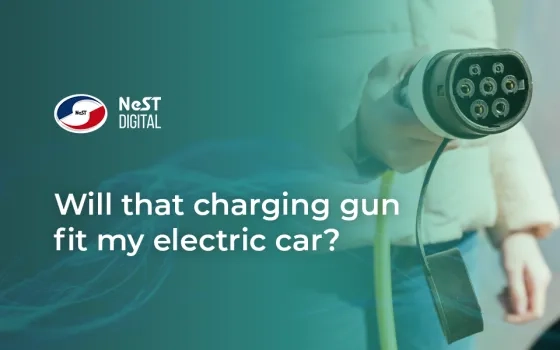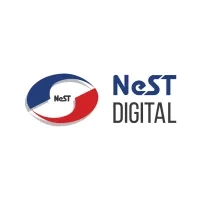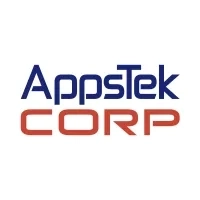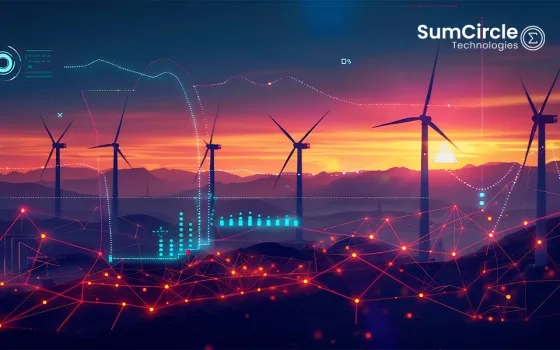Abstract
EV charging standards assure electric car (EV) users of compatibility with EV Chargers (EVSEs). The landscape of EV charging standards is fragmented with no single global standard. Regional associations and industry leaders have defined their respective standards so far, which were promoted by regulatory legislations for specific geographies. Compliance from both EV OEMs, as well as EV Charger manufacturers, is a must to make compatibility a reality. An EV charging standard is not a single standard, rather it is an umbrella of multiple constituent standards dealing with various aspects of EV charging. Each EV charging standard has tried to consolidate in its home ground while attempting to penetrate overseas markets, incorporating the latest developments in EV charging in order to remain competitive.
Introduction
Thinking of switching over to an electric car? Well, do you drive long distances on business or holiday? If so, then one of your first concerns will be about recharging midway from public charging stations. So, is the EV model you are considering compatible with those charging stations (or vice versa)? With your petrol/diesel car, you are fully confident that the nozzle of any fuel station in the country will fit into your tank’s inlet, no matter the choice of fuel grade. With your new electric car however, will the charging gun of every installed public charging station fit into its charging inlet and work safely and correctly?
EV charging compatibility
For charging any battery, ranging from a UPS battery to a cell phone battery, the input electrical parameters depend on the country-specific grid standard. For instance, 230V/1-Phase or 400V/3-Phase and 50 Hz in India. Whereas the output parameters will be specific to the battery design. More or less similarly, the EV charging standard adopted by a particular country ensures that all EVs manufactured for use in that region are compatible with public chargers installed there. So, the short answer to the concern is that if your EV is locally manufactured, then you can be reasonably assured that it will be compatible with the locally installed public chargers.
However, when it comes to an imported EV it turns out to be fuzzy! For instance, if you plan to import a made-in-Japan EV, are you sure it can be charged from public chargers in India? What about a Chinese import? Well, it looks like the answers are not in black or white! So, let’s try to understand the WHYs and HOWs of EV — EVSE compatibility. (Where EVSE stands for Electric Vehicle Supply Equipment, or the EV charger).
Compatibility requirements
Firstly, when we talk of public charging, we are referring for the most part to DC Fast charging. Public charging does include DC Ultra-fast charging as well, although uptake is still to happen in countries like India. In DC Fast charging the output DC voltage is typically 500V, providing power output of typically 150kW, whereas for DC Ultra-fast charging it is typically 800V and upward of 300kW. The input parameters (for both types) depend on the grid standard adopted in India as mentioned above.
However, EV–EVSE compatibility is not limited to interoperability of voltage and power, it also involves compatibility at various levels between the car and the EV Charger — mechanical (connector dimensions, pinout), max. electrical ratings, EV-EVSE communication, thermal management, safety etc. Most importantly, compliance from both EV OEMs as well as EV Charger manufacturers is a must to make compatibility a reality. For instance, an electric car manufactured by Tata Motors should be compatible with a DC Fast charger design from Delta Electronics, or a charging station installed by Exicom should be compatible with an electric tractor manufactured by TAFE.
Standardization of EV Charging
The Automotive Research Association of India (ARAI) is the vanguard in India that governs compatibility by publishing standards and guidelines and enforces them through compliance testing and certification services, for both EVs as well as EVSEs in the country. The Automotive Industry Standard AIS-138 (Part-2) is the ARAI standard for DC Fast charging, which extensively cross references global standards, like IEC 61851 for basic conductive charging system and its electrical/safety aspects and analog signalling, DIN SPEC 70121 and ISO 15118 for high level communication and other related European standards for connectors etc. ARAI also publishes Automotive Industry Standard AIS-038 for the construction and functional safety of Electric Power Train vehicles, as well as defines the type qualification tests for all categories of EVs besides laying down guidance for the measurement of power output, electrical energy consumption and range of EVs.
Note: The scope of ARAI extends not only into other areas of EV and EVSE, like hybrid electric vehicles and AC charging, but also into fossil fuel vehicles as well.
Global EV charging standards
At the global stage, a single standard to govern EV–EVSE compatibility has always remained elusive, and is likely to remain a utopian dream. Just as electrical systems around the world are fragmented (and finitely so), so are EV charging standards. As of today, the Combined Charging System (CCS) with its 2 variants CCS1 (US) and CCS2 (Europe), CHAdeMO (Japan), GB/T (China) and Tesla are the global EV charging standards.
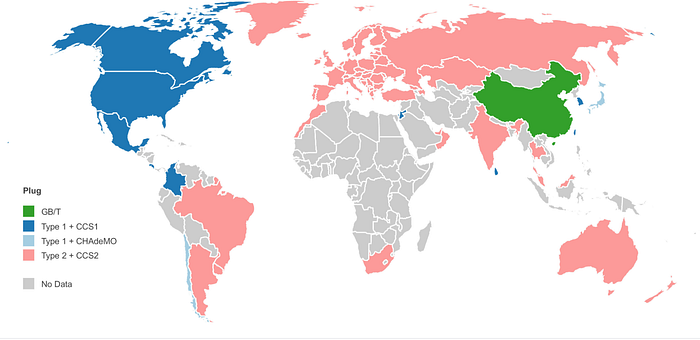
Global EV charging standards and geographies (Image courtesy: Science Direct)
War of the plugs!
A glance at the charging connector, one of the many aspects of an EV charging standard, gives a sense of wide variations across competing standards.
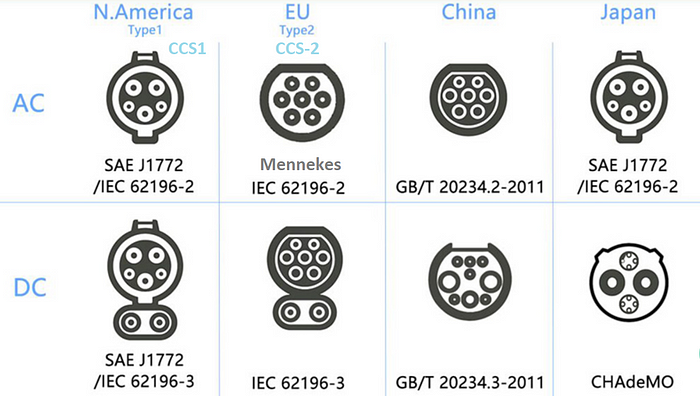
Charging connectors of global EV charging standards (Image courtesy: Renhotec EV)
Note: The connector layout and pin arrangement at the outlet/gun of the EV Charger and that at the inlet of the car are mirror images of one another.
Evolution of EV charging standards
Let us trace briefly the history of EV charging standards.
CHAdeMO
The CHAdeMO association in Japan were the first movers in 2010 for a standardized fast charging system for battery electric vehicles. It was formed by the Tokyo Electric Power Company and a few Japanese automakers — Toyota, Nissan, Mitsubishi, Subaru, Hitachi, Honda and Panasonic. Although not all at the same time, they agreed on a proprietary CAN (Controller Area Network) based protocol for the communication between the car and the EV Charger. Since then CHAdeMO has seen widespread deployment in Japan.
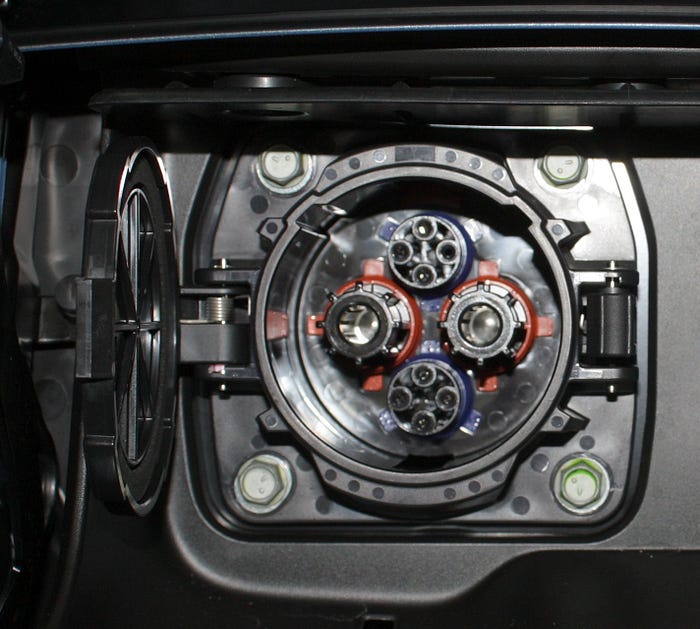
Charging inlet of Nissan Leaf EV (for use in Japan only), showing the CHAdeMO connector (Image courtesy: Wikimedia Commons)
Soon CHAdeMO’s success travelled beyond the Japanese archipelago as it gained the status of an international standard in 2014, following which it found traction in international markets, like North America and Europe. Over 50+ CHAdeMO manufacturers have an installed base of public fast chargers across 60+ countries. Various models from BMW, Mitsubishi, Mazda, Citroen, Lexus, Nissan, Peugeot, Subaru, Toyota and Tesla support (or used to support at some point of time) CHAdeMO as a standard or optional inlet.
Note: “CHAdeMO” was coined as an abbreviation of “CHArge de MOve”, equivalent to “charge for moving”, and is a pun for “O cha demo ikaga desuka” in Japanese, which means “Let’s have a tea while charging”, which really symbolized fast charging at that time!
However, CHAdeMO had a major setback when the Combined Charging System was designated by the European Commission as the standard for public fast charging in Europe. EU regulations did not mandate removing or phasing out CHAdeMO, it only directed that all public chargers in the EU were to be equipped with CCS2 Combo connector. This allowed charger manufacturers to have multiple connector options in the charger, including CHAdeMO.
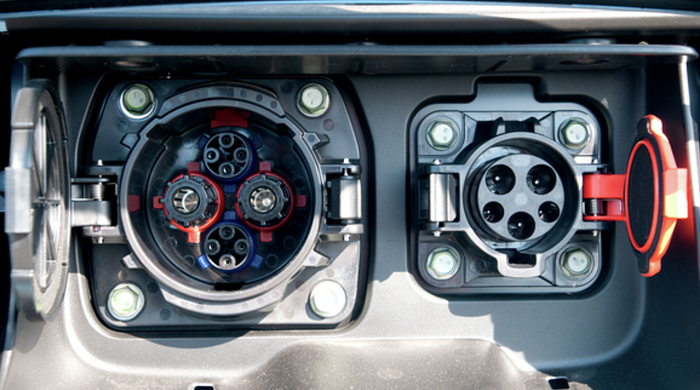
Charging inlet of Nissan Leaf EV (US version) Shows additional CCS Type1 connector for AC charging, in addition to CHAdeMO connector for DC charging (Image courtesy: The Tech)
More precisely, the technical specifications (Annex II) of the EU directive on the development of infrastructure for Alternative Fuels of 2014 states that “Direct current (DC) high power recharging points for electric vehicles shall be equipped as of 2017, for interoperability purposes, at least with connectors of the Combined Charging System ‘Combo 2’ as described in standard IEC 62196–3.”, that defines the dimensional compatibility and interchangeability requirements of specific designs of plugs, socket-outlets, vehicle connectors and vehicle inlets related to public charging. This is the piece of EU legislation that launched CCS as the predominant standard in Europe, and later in other parts of the world like the US where the Society of Automotive Engineers (SAE) welcomed CCS as an obvious extension to the existing AC charging standard.

Charging inlet of Nissan Leaf EV (EU version) Shows additional CCS Type2 connector for AC charging, in addition to CHAdeMO connector for DC charging (Image courtesy: TeslaClub)
These developments led to CHAdeMO steadily losing market share, with even some of its association members like Honda and Nissan ditching CHAdeMO connectors on their models sold outside Japan. Nevertheless, CHAdeMO still remains the predominant EV charging standard in Japan.
Combined Charging System (CCS)
The Combined Charging System (CCS) standard was introduced in 2012 by seven European and North American auto makers — Audi, BMW, Daimler, Ford, General Motors, Porsche and Volkswagen. At that time the ISO15118 standard that defined use of the HomePlug GreenPHY protocol (based on Power Line Communication) wasn’t fully ready for release. So, in the interim, CCS chose the German standard DIN SPEC 70121 (that used a similar protocol) for high level communication between the car and the EV Charger. Subsequently ISO15118 was adopted by CCS when it was released in 2014 to supersede DIN SPEC 70121 as the high-level communication standard. Later CCS came under the governance of the CharIN (Charging Interface Initiative e.V.) association which today consists of more than 300 members dedicated to promoting interoperability based on CCS.
CCS Type1 (and Combo1)
CCS Type 1 (and Combo 1) connectors gained popularity in North America (120 V system), soon finding traction in Taiwan and South Korea.
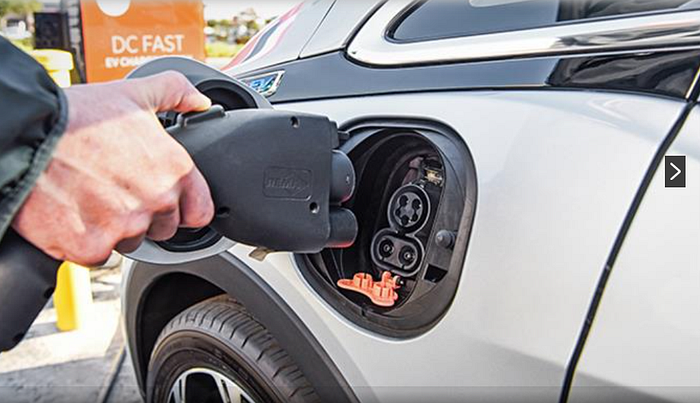
Charging gun/inlet of General Motors EV (unknown model), showing CCS Combo1 connector (Image courtesy: AutocarPro)
CCS Type2 (and Combo2)
While CCS Type 2 (and Combo 2) connectors became widespread in Europe (240 V system), followed by other geographies like South America, South Africa, India, Singapore and Australia.
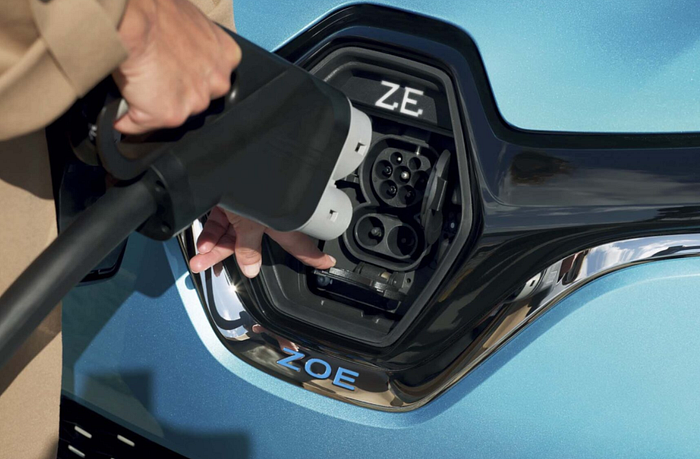
Charging gun/inlet of Renault Zoe EV, showing CCS Combo2 connector (Image courtesy: Renault)
Meanwhile on the public charging infrastructure front, CCS charger installations have outnumbered CHAdeMO chargers in the US as of 2020.
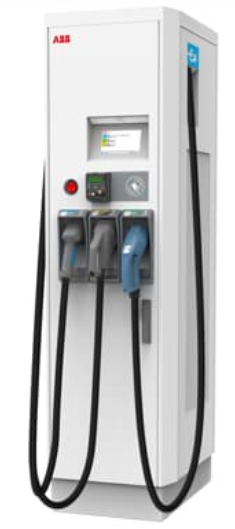
ABB Terra 54 CJG DC Fast Charger, with multiple charging gun options — CHAdeMO, CCS2 and AC charging (Image courtesy: ABB)
CHAdeMO
We saw earlier how CHAdeMO lost its foothold in Europe with the EU directive, and later in the US. However, it is to be appreciated how CHAdeMO was retained by CCS as an option for manufacturers. The IEC 61851 standard that was adopted by CCS had made provision for 3 alternative options for digital communication:
· System A — CAN bus A interface, defined by IEC 61851–24, for CHAdeMO
· System B — CAN bus B interface, defined by the GB/T 27930, for GB/T
· System C — Power Line Communication (PLC), defined by ISO15118, for CCS
In this non-exclusivity of communication options, we can see CCS as kind of grandfathering CHAdeMO, perhaps to honour the already installed base of CHAdeMO chargers and compatible cars in the EU. Nevertheless, CHAdeMO was unable to withstand the market forces in the EU and the US, and is being relegated to its home turf of Japan.
GB/T
GB/T charging standard was developed in China led by the China Electricity Council, and is largely limited to the Chinese market, incidentally the largest EV market.
Tesla
Anything that is proprietary is hardly a standard, so “Tesla standard” may turn out to be an oxymoron! Although not an open standard, let’s look at the Tesla connector as well for completeness sake.
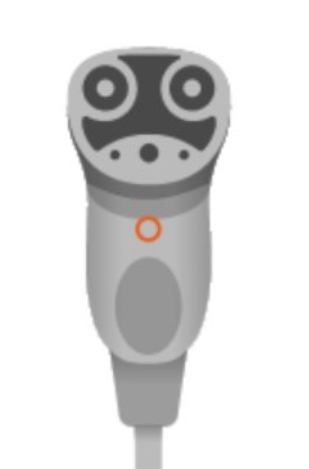
Tesla EV Charger (gun) connector (Image courtesy: Connector Tips)
Don’t worry, it is not an ET from Star Wars! It is only Tesla’s proprietary connector design.
Even Tesla has had to pivot to provide CCS2 charging outlets in their Superchargers installed in Europe, and also provide (separately sold) CCS2 adapter for their cars sold in the EU. (Does this remind of Apple having to provide USB Type-C slot on iPhones sold in Europe!) Tesla EVs have accommodated the CCS2 connector in the inlet alongside the proprietary Tesla connector, so that owners can leverage the vast CCS2 public charging infrastructure in the EU that is far denser than the installed base of Tesla Superchargers.
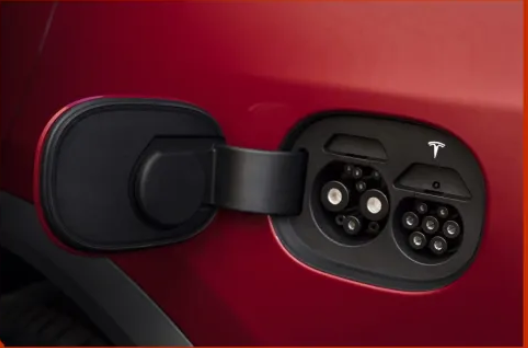
Updated Tesla Model S EV charging inlet Shows CCS2 connector in addition to Tesla proprietary connector (Image courtesy: Electrek)
CCS — What’s under the hood?
Let’s look in some detail into the Combined Charging System (CCS) standard. Why choose this particular standard for deep dive? From the above discussion and pictures, it is evident that competing standards like CHAdeMO and Tesla are making space for CCS to retain their market share. Further although it originally became popular in Europe, CCS2 was adopted subsequently by many other countries, including India, and is arguably the most prevalent global standard today.
CCS is an open, universal and international charging system for electric vehicles based on international standards — one system for all. It combines single phase and three phase AC charging, along with Fast DC charging (most important for public charging). It is a combination of hardware and software, that ranges from defining the connector, managing of the control functions and the charging communication between the electric vehicle and the charging infrastructure.
The basic electrical interface specification for power transmission that includes safety aspects like charging socket lock and safety-related (analog) signalling is defined by IEC61851. Connector dimensions and electrical ratings follow the IEC 62196 standard. Since the original Type 2 connector design was made by the manufacturer Mennekes (Germany), it is also colloquially known as the Mennekes connector. Further CCS introduced the Combo2 connector that combines pins for both AC charging and DC charging in Europe.
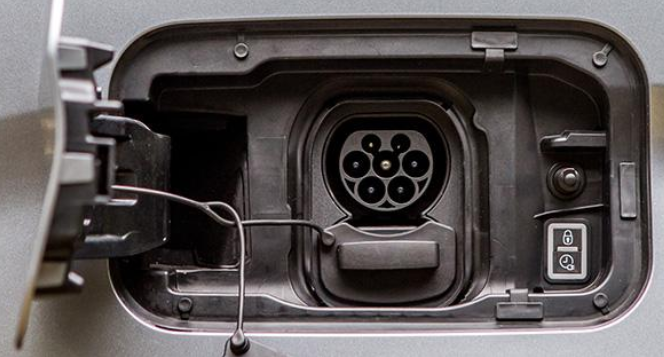
Peugeot EV (unknown model) charging inlet with CCS Combo 2 connector. Note the 2 DC pins covered by the closed lower cap (Image courtesy: ZapMap)
While in the US, the Type 1 connector is popularly known as the SAE J1772 connector. Further CCS introduced the Combo1 connector that combines pins for both AC charging and DC charging in the US.
High Level Communication uses the standards ISO 15118 and DIN SPEC 70121 (now obsolete). The communication uses TCP/IP channel based on HomePlug GreenPHY (Power Line Communication), protected by TLS security that offers better security for encrypted authentication and secure payment, compared to the CAN bus communication adopted by CHAdeMO and GB/T standards.
CCS has been continuously evolving and adopting the latest trends in EV charging — smart charging, plug-n-charge, bidirectional charging (vehicle to grid), wireless (inductive) charging, and automatic connection devices (robotic arms and pantographs). A working group at CharIN is also working on Extended High Power (or MegaWatt) charging connector for specialty EVs like trucks and buses that can take multiple MW of charging power.
Compatible or not
Our EV Charger designs conform to CCS2 standards to address both the Indian and European markets. The shortly upcoming ARAI testing and certification activity will ensure that any compatible electric (or hybrid) car, like a Tata Nexon EV or a Hyundai Kona EV, can be safely plugged into it and charged.
Meanwhile, let us see if we have the answer to the compatibility questions regarding imported EVs. Well, it turns out that if it is a Japanese make EV model that was manufactured for use in Japan only, it will have only the CHAdeMO connector in the inlet, so it cannot be charged from CCS2 public charging stations in India. However, if it is a model that was manufactured for the international market like the EU, then it will additionally have a CCS2 connector in the inlet, which means it can be used in India. Whereas in the case of the imported Chinese EV, one tends to think that since it will have only GB/T inlet, it cannot be charged in India. Quite counterintuitively, DC Fast chargers with GB/T gun option (and CAN based communication) are manufactured and installed in India, although they are few in number!
Standardization trends
From the above discussion, we can see that an EV charging standard is not really a single self-contained standard, rather it is an umbrella of multiple constituent standards, each one dealing with a particular aspect of EV charging — connector definition, electrical parameters, communication system and safety features, that has been adopted by legislation by policymakers of the respective geography.
For the same reason and owing to their history of evolution, the standardization landscape is not expected to change drastically in the next 3–5 years. China the largest EV market today will continue to promote GB/T, whereas the rest of the world will resist adopting it. Meanwhile CCS2 will continue its predominance in Europe, and consolidate in India and other geographies and try to further expand its footprint. The US will continue with a mixture of CCS1 and CHAdeMO till the time the latter gets fully phased out, not by legislation though. This shift could spur some aftermarket action for CCS-2 retrofit kits for existing CHAdeMO cars, as well as smart CCS2-CHAdeMO charging adapters. CHAdeMO will lose further market share in both the US and the EU and eventually be relegated to the Japanese market only.
However, this hardly means that the landscape will remain static. Firstly, many changes are expected to happen with each global standard, with each of them continuing to incorporate new and emerging sub-standards related to smart charging, bidirectional charging, wireless charging, automatic connection device etc. On a different dimension, cooperation between erstwhile competitors is also happening. The China Electricity Council and the CHAdeMO Association of Japan are collaborating on an ambitious EV charging standardization project for ultra-fast charging, that has “CHaoJi” as its working name. This new global standard released in 2020 is believed to be backward compatible with the existing GB/T (Chinese) and CHAdeMO (Japanese) standards. So, the arena of EV charging standards promises to be action-packed!
Conclusion
As electrification gains momentum in the coming years to help governments achieve their global climate commitments, several new features for Smart Charging and grid-friendliness are expected to be incorporated into all major EV Charging standards. Both EV OEMs, as well as EV Charger manufacturers, will need to closely follow the changes in the latest releases of the standards to assure compatibility and retain/gain their market share.
Author Details
Ram Mohan Ramakrishnan
Principal Consultant, NeST Digital



